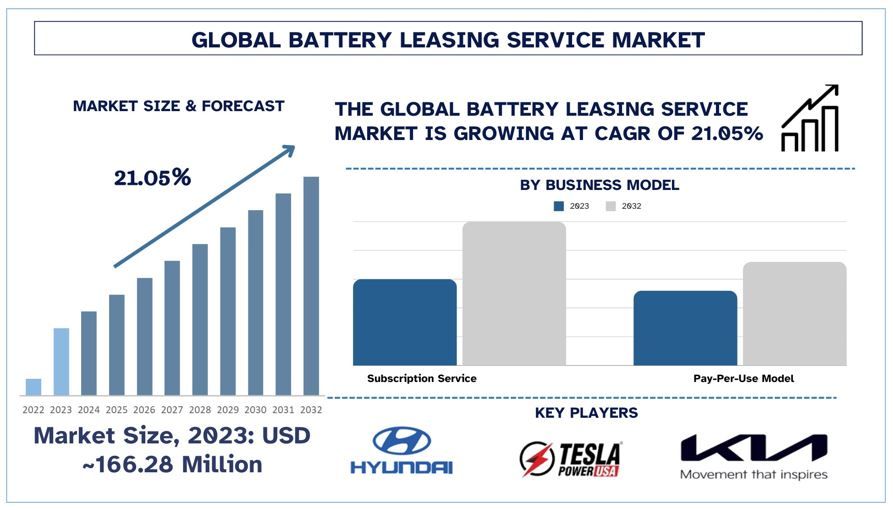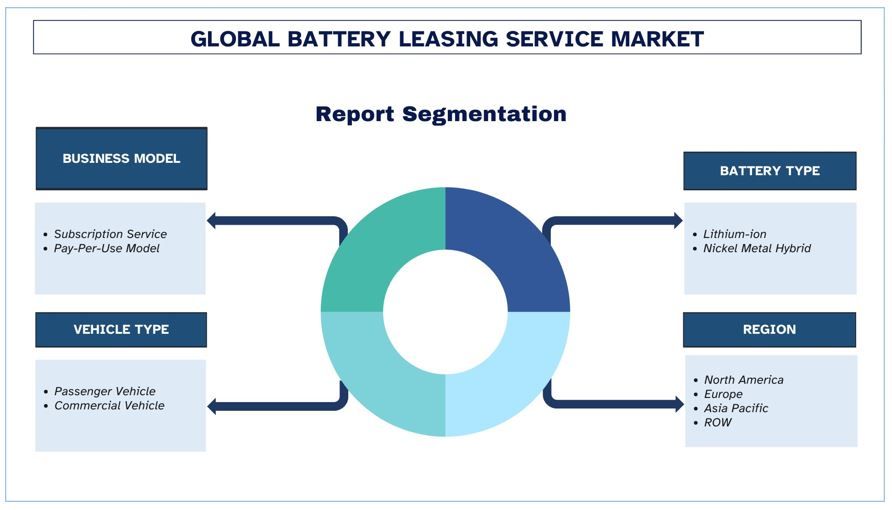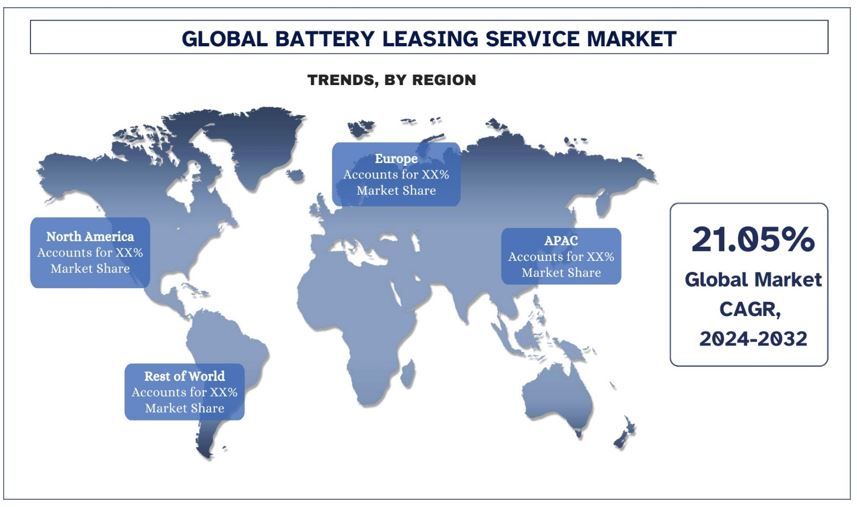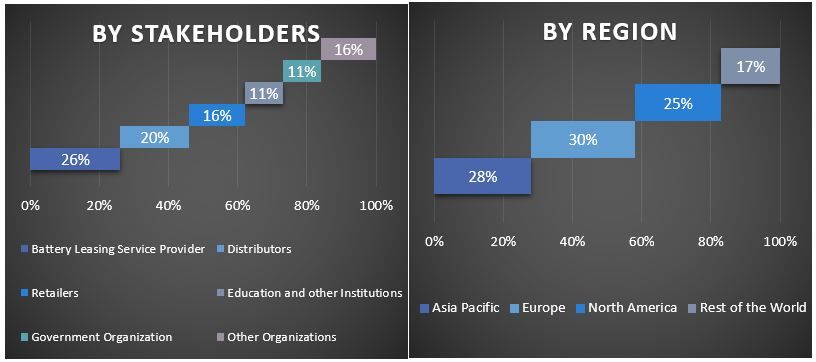- Accueil
- À propos de nous
- Industrie
- Services
- Lecture
- Contactez-nous
Marché des services de location de batteries : Analyse actuelle et prévisions (2024-2032)
Accent mis sur le modèle économique (service d'abonnement, modèle de paiement à l'utilisation), Type de batterie (Lithium-ion, Nickel-métal hydrure) ; Type de véhicule (Véhicule particulier, Véhicule utilitaire) ; Région/Pays

Taille et prévisions du marché des services de location de batteries
La valeur du marché des services de location de batteries était de 166,28 millions USD en 2023 et devrait croître à un TCAC important d'environ 21,05 % au cours de la période de prévision (2024-2032). Le marché des services de location de batteries est en plein essor, car il s'est avéré être un modèle commercial rentable et durable pour posséder des véhicules électriques (VE) et des systèmes de stockage d'énergie. Cette option offre plus de flexibilité en termes de mise à niveau et réduit le coût initial, car les utilisateurs n'achètent pas les batteries, mais les louent. Ce modèle répond à l'un des principaux défis de la mise en œuvre des VE : le coût élevé des batteries. Du point de vue commercial, il est avantageux, car il nécessite moins d'investissement en capital au départ et maintient des coûts opérationnels répartis uniformément et régulièrement.
Plusieurs entreprises européennes étudient les services de location de batteries pour les opérateurs de flotte afin d'améliorer l'efficacité et la durabilité. Ce modèle pourrait être étendu à d'autres secteurs où les systèmes de stockage d'énergie sont essentiels, en particulier dans les projets d'énergies renouvelables et les industries. Les ventes de VE continuent de croître, tout comme la demande de solutions de batteries de nouvelle génération plus flexibles, économiques et à haute densité énergétique. En outre, le soutien gouvernemental actuel au déploiement de technologies vertes et l'intérêt croissant pour l'économie circulaire, y compris le recyclage des batteries, créent les bases du développement des services de location de batteries. En termes de perspectives générales du secteur, le modèle présente une synergie importante avec l'accent croissant mis sur l'économie du partage et la durabilité, renforçant ainsi le potentiel de croissance du secteur.
Analyse du marché des services de location de batteries
Les principales entreprises du marché des services de location de batteries investissent également davantage dans la diversification des services et l'amélioration de la qualité du service. De nombreux constructeurs automobiles mondiaux, dont Tesla, NIO et Gogoro, ont adopté de nouvelles stratégies de location de batteries pour répondre aux demandes actuelles du marché. Tesla a envisagé des stratégies de location de batteries pour réduire le coût de ses voitures électriques et les rendre abordables pour le consommateur moyen. Une autre entreprise automobile chinoise clé et émergente, à savoir NIO, a conçu un système d'échange de batteries où les consommateurs peuvent échanger leurs batteries déchargées contre des batteries chargées après un certain temps dans les stations d'échange. Ce modèle vise à résoudre les deux principales sources de préoccupation des clients, à savoir l'autonomie de la batterie et le temps de charge, améliorant ainsi la convivialité du transport électrique.
Tendances du marché des services de location de batteries
Demande croissante de véhicules électriques automobiles : Une tendance croissante est observée dans la région Asie-Pacifique en matière de location de batteries en raison de la demande de véhicules électriques automobiles et des besoins de stockage d'énergie. La Chine, l'Inde et le Japon sont à la pointe de ce développement grâce à différents programmes de location de batteries. Actuellement, des acteurs tels que NIO et BAIC ont lancé des services d'échange de batteries en Chine, où les cas d'utilisation de VE continuent d'augmenter, principalement dans les villes. La location de batteries est envisagée en Inde pour faire face à l'investissement coûteux dans les VE et s'aligner sur la vision du gouvernement en matière de transport électrique.

La région Asie-Pacifique devrait croître avec un TCAC important au cours de la période de prévision
L'Asie-Pacifique a contribué de manière significative à l'expansion du marché des services de location de batteries. Le marché de la location de batteries est fortement orienté vers la région Asie-Pacifique en raison d'un marché de VE en croissance, de politiques gouvernementales favorables et d'un client qui se tourne vers des modes de transport abordables. Actuellement, la Chine, l'Inde, le Japon et la Corée du Sud ont enregistré des taux élevés d'adoption des véhicules électriques sur la base d'objectifs nationaux ambitieux fixés pour la consommation d'énergie verte et les systèmes de transport à faibles émissions.
En outre, divers gouvernements de la région offrent des incitations, des subventions et des exonérations fiscales pour les modèles de VE et de location de batteries afin d'améliorer l'attrait du marché de masse. Le marché chinois a reçu un coup de pouce grâce à des acteurs clés tels que CATL et BYD dans la fabrication de batteries et à des innovations telles que les solutions d'échange et de location de batteries. Dans les zones à forte concentration de population, la location de batteries est également populaire pour minimiser le temps de charge et les inquiétudes concernant la durabilité de la batterie. Par conséquent, avec les progrès rapides de l'infrastructure de location de batteries, la région Asie-Pacifique continuera de dominer le marché mondial de la location de batteries dans les années à venir.

Aperçu de l'industrie des services de location de batteries
- Le marché des services de location de batteries est concurrentiel et fragmenté, avec la présence de plusieurs acteurs mondiaux et internationaux. Les principaux acteurs adoptent différentes stratégies de croissance pour améliorer leur présence sur le marché, telles que des partenariats, des accords, des collaborations, des lancements de nouveaux produits, des expansions géographiques, ainsi que des fusions et acquisitions. Parmi les principaux acteurs opérant sur le marché figurent Hyundai, Tesla Power USA, Proterra, Volkswagen, Numocity, Ocotillo Power Systems, Oyika Pte Ltd., Renault Group, VoltUp et Kia Motors Inc.
Actualités du marché des services de location de batteries
- En 2023, Kia Corporation s'est associé à plusieurs entreprises locales pour lancer un service pilote d'abonnement aux batteries de véhicules électriques (VE). Le constructeur automobile a signé un protocole d'entente (MoU) avec Hyundai Capital Services, Shinhan EZ General Insurance, l'Association des taxis de Séoul, Sangrok Transportation et Hanmi Taxi pour lancer un abonnement aux batteries dans le but ultime de réduire le coût d'achat des VE en réduisant les frais de location des batteries.
Couverture du rapport sur le marché des services de location de batteries

Raisons d'acheter ce rapport :
- L'étude comprend une analyse de la taille et des prévisions du marché validée par des experts clés authentifiés du secteur.
- Le rapport présente un aperçu rapide de la performance globale du secteur en un coup d'œil.
- Le rapport couvre une analyse approfondie des principaux acteurs du secteur, en mettant l'accent sur les principaux éléments financiers, les portefeuilles de produits, les stratégies d'expansion et les développements récents de l'entreprise.
- Examen détaillé des moteurs, des contraintes, des tendances clés et des opportunités qui prévalent dans le secteur.
- L'étude couvre de manière exhaustive le marché à travers différents segments.
- Analyse approfondie au niveau régional de l'industrie.
Options de personnalisation :
Le marché mondial des services de location de batteries peut être davantage personnalisé selon les besoins ou tout autre segment de marché. En outre, UMI comprend que vous pouvez avoir vos propres besoins commerciaux. N'hésitez pas à nous contacter pour obtenir un rapport qui répond parfaitement à vos besoins.
Table des matières
Méthodologie de recherche pour l'analyse du marché des services de location de batteries (2024-2032)
L'analyse du marché historique, l'estimation du marché actuel et la prévision du marché futur du marché mondial des services de location de batteries ont été les trois principales étapes entreprises pour créer et analyser l'adoption des services de location de batteries dans les principales régions du monde. Une recherche secondaire exhaustive a été menée pour collecter les chiffres du marché historique et estimer la taille du marché actuel. Deuxièmement, pour valider ces informations, de nombreux résultats et hypothèses ont été pris en compte. De plus, des entretiens primaires exhaustifs ont également été menés avec des experts de l'industrie à travers la chaîne de valeur du marché mondial des services de location de batteries. Après l'hypothèse et la validation des chiffres du marché par le biais d'entretiens primaires, nous avons utilisé une approche descendante/ascendante pour prévoir la taille complète du marché. Par la suite, des méthodes de ventilation du marché et de triangulation des données ont été adoptées pour estimer et analyser la taille du marché des segments et sous-segments de l'industrie concernée. La méthodologie détaillée est expliquée ci-dessous :
Analyse de la taille du marché historique
Étape 1 : Étude approfondie des sources secondaires :
Une étude secondaire détaillée a été menée pour obtenir la taille du marché historique du marché des services de location de batteries à partir de sources internes à l'entreprise telles que les rapports annuels et les états financiers, les présentations de performance, les communiqués de presse, etc., et de sources externes, notamment les revues, les actualités et les articles, les publications gouvernementales, les publications des concurrents, les rapports sectoriels, les bases de données tierces et d'autres publications crédibles.
Étape 2 : Segmentation du marché :
Après avoir obtenu la taille du marché historique du marché des services de location de batteries, nous avons mené une analyse secondaire détaillée pour recueillir des informations sur le marché historique et la part des différents segments et sous-segments pour les principales régions. Les principaux segments inclus dans le rapport sont le modèle commercial, le type de batterie, le type de véhicule et la région. De plus, des analyses au niveau des pays ont été menées pour évaluer l'adoption globale des modèles de test dans cette région.
Étape 3 : Analyse des facteurs :
Après avoir acquis la taille du marché historique des différents segments et sous-segments, nous avons mené une analyse détaillée des facteurs pour estimer la taille actuelle du marché des services de location de batteries. De plus, nous avons mené une analyse des facteurs à l'aide de variables dépendantes et indépendantes telles que le modèle commercial, le type de batterie et le type de véhicule du marché des services de location de batteries. Une analyse approfondie a été menée des scénarios de l'offre et de la demande en tenant compte des principaux partenariats, des fusions et acquisitions, de l'expansion des activités et des lancements de produits dans le secteur du marché des services de location de batteries à travers le monde.
Estimation et prévision de la taille actuelle du marché
Taille actuelle du marché : Sur la base des informations exploitables tirées des 3 étapes ci-dessus, nous sommes parvenus à la taille actuelle du marché, aux principaux acteurs du marché mondial des services de location de batteries et aux parts de marché des segments. Toutes les répartitions de parts de pourcentage requises et les ventilations du marché ont été déterminées à l'aide de l'approche secondaire susmentionnée et ont été vérifiées par le biais d'entretiens primaires.
Estimation et prévision : Pour l'estimation et la prévision du marché, des pondérations ont été attribuées à divers facteurs, notamment les moteurs et les tendances, les contraintes et les opportunités disponibles pour les parties prenantes. Après avoir analysé ces facteurs, des techniques de prévision pertinentes, c'est-à-dire l'approche descendante/ascendante, ont été appliquées pour parvenir à la prévision du marché 2032 pour différents segments et sous-segments à travers les principaux marchés mondiaux. La méthodologie de recherche adoptée pour estimer la taille du marché comprend :
- La taille du marché de l'industrie, en termes de revenus (USD) et le taux d'adoption du marché des services de location de batteries à travers les principaux marchés nationaux
- Toutes les parts de pourcentage, les divisions et les ventilations des segments et sous-segments de marché
- Principaux acteurs du marché mondial des services de location de batteries en ce qui concerne les produits offerts. De plus, les stratégies de croissance adoptées par ces acteurs pour rivaliser sur le marché en croissance rapide.
Validation de la taille et de la part du marché
Recherche primaire : Des entretiens approfondis ont été menés avec les principaux leaders d'opinion (KOL), notamment les cadres de haut niveau (CXO/VP, chef des ventes, chef du marketing, chef des opérations, chef régional, chef de pays, etc.) dans les principales régions. Les résultats de la recherche primaire ont ensuite été résumés et une analyse statistique a été effectuée pour prouver l'hypothèse énoncée. Les contributions de la recherche primaire ont été consolidées avec les résultats secondaires, transformant ainsi l'information en informations exploitables.
Répartition des participants principaux dans différentes régions

Ingénierie du marché
La technique de triangulation des données a été utilisée pour compléter l'estimation globale du marché et pour obtenir des chiffres statistiques précis pour chaque segment et sous-segment du marché mondial des services de location de batteries. Les données ont été divisées en plusieurs segments et sous-segments après avoir étudié divers paramètres et tendances dans les domaines du modèle commercial, du type de batterie et du type de véhicule sur le marché mondial des services de location de batteries.
L'objectif principal de l'étude du marché mondial des services de location de batteries
Les tendances actuelles et futures du marché mondial des services de location de batteries ont été mises en évidence dans l'étude. Les investisseurs peuvent obtenir des informations stratégiques pour fonder leur discrétion en matière d'investissements sur l'analyse qualitative et quantitative réalisée dans l'étude. Les tendances actuelles et futures du marché ont déterminé l'attractivité globale du marché au niveau régional, offrant une plateforme aux participants industriels pour exploiter le marché inexploité afin de bénéficier d'un avantage de premier entrant. Les autres objectifs quantitatifs des études comprennent :
- Analyser la taille actuelle et prévue du marché des services de location de batteries en termes de valeur (USD). De plus, analyser la taille actuelle et prévue du marché des différents segments et sous-segments.
- Les segments de l'étude comprennent les domaines du modèle commercial, du type de batterie et du type de véhicule.
- Définir et analyser le cadre réglementaire des services de location de batteries
- Analyser la chaîne de valeur impliquée avec la présence de divers intermédiaires, ainsi qu'analyser les comportements des clients et des concurrents de l'industrie.
- Analyser la taille actuelle et prévue du marché des services de location de batteries pour la région principale.
- Les principaux pays des régions étudiées dans le rapport comprennent l'Asie-Pacifique, l'Europe, l'Amérique du Nord et le reste du monde
- Profil d'entreprise du marché des services de location de batteries et les stratégies de croissance adoptées par les acteurs du marché pour se maintenir sur le marché en croissance rapide.
- Analyse approfondie au niveau régional de l'industrie
Questions Fréquemment Posées FAQ
Q1 : Quelle est la taille actuelle du marché et le potentiel de croissance du marché des services de location de batteries ?
Q2 : Quels sont les principaux moteurs de la croissance du marché des services de location de batteries ?
Q3: Quel segment détient la plus grande part du marché des services de location de batteries par modèle commercial ?
Q4 : Quelles sont les technologies émergentes et les tendances du marché des services de location de batteries ?
Q5 : Quelle région dominera le marché des services de location de batteries ?
Connexes Rapports
Les clients qui ont acheté cet article ont également acheté










